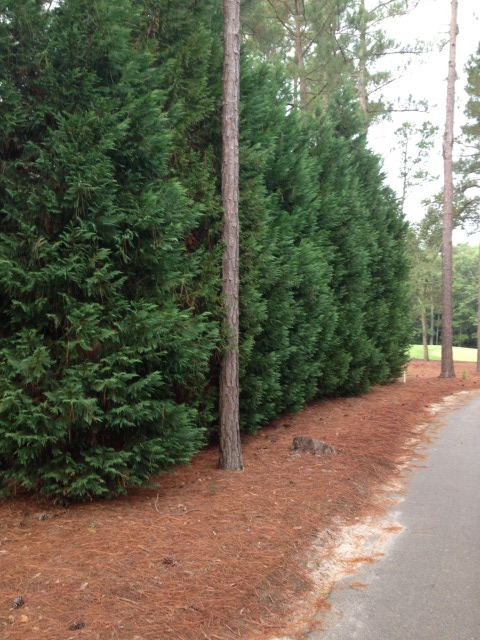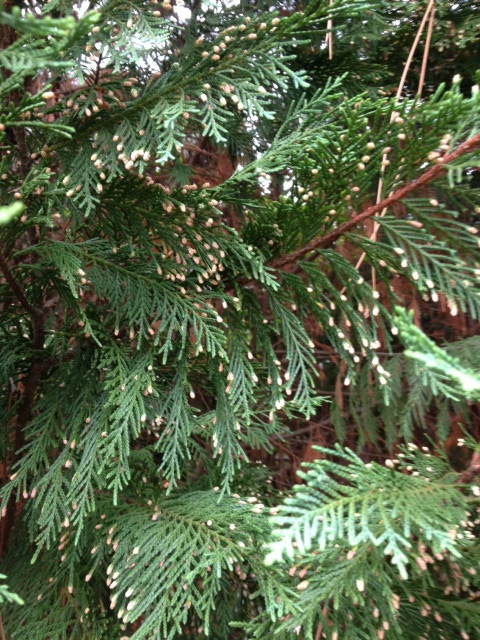Question
 Cypress 1
Cypress 1  Cypress 2
Cypress 2
Dear Mr. Hyland:
I read one of your other responses regarding white dots. As you can see the house we purchased has a large row of Cypress, and even more on the inside row that you can't see. They were planted to create privacy for the pool, but obviously they were planted too close together.
One tree died last year, it just turned brown, and most recently one of the trees developed the white dots. Strangely enough, none of the others exhibit this problem and appear very healthy. The trees were planted in 2004 and I can only assume they were significant size as you can see the 10 year growth.
Do you think this is an insect or the cones as you mnetionned in the earlier post?
AnswerThese are the cones of the cypress. They will grow over time and you will see more cone shapes.
The dying tree had nothing to do with the cones. Leyland cypress trees are subject to a couple of canker type diseases that effect the foliage.
Seiridium canker is probably the most important and destructive disease on Leyland cypress in the landscape. Although the fungi Seiridium cardinale, Seiridium unicorne, and Seiridium cupressi have been reported to cause disease on Leyland cypress and other needled evergreens, only Seiridium unicorne is most commonly associated with cankers and twig dieback on Leyland cypress.
One of the most noticeable symptoms of Seiridium canker is yellowing or browning of the foliage on one or more top or lateral branches. The discoloration is most likely to appear in early spring; however, it can be seen at any time of the year. The disease expansion often continues until a significant portion of the tree is destroyed. Upon closer examination, formation of numerous thin, elongated cankers is observed on stems, branches and branch axils. These cankers cause twig and branch dieback. Most of the cankers are slightly sunken, with raised margins, and they may be discolored dark brown to purple. Cracked bark in infected areas is often accompanied by extensive resin exudates that flow down the diseased branches. The cambial tissue beneath oozing sites is discolored with a reddish to brown color.
Sanitation, such as removal of cankered twigs and branches, helps prevent disease spread. Destroy pruned materials, and disinfect pruning tools by rinsing in rubbing alcohol or a solution of 1 part bleach to 9 parts water. Remove extensively damaged trees or trees that are damaged in the main trunk.
No cultivars or selections are known to be resistant to the disease. In the landscape, fungicides are seldom used and they provide no control once an infection has taken place.
Another damaging disease on Leyland cypress in landscapes is a canker and dieback named Botryosphaeria (Bot) canker, caused by the fungus Botryosphaeria dothidea. This aggressive disease affects a number of woody shrubs and trees worldwide, and it has been reported on azaleas, rhododendrons, flowering dogwoods and redbuds, among others. Plants suffering from environmental stresses (freezing, drought, or heat) or wounds are particularly susceptible to B. dothidea infection in landscape plantings.
In the landscape, Bot canker symptoms resemble those caused by Seiridium canker. Bright, rust-colored branches and yellowing or browning of shoots or branches are the first observed symptoms. Closer inspection reveals the presence of sunken, girdling cankers at the base of the dead shoot or branch. Sometimes, the main trunk shows cankers that might extend for a foot or more in length. These cankers rarely girdle the trunk, but they will kill branches that may be encompassed by the canker as it grows.
Canker surfaces may be cracked and have a darker color than the surrounding healthy bark. The discoloration often extends several inches below the canker periphery. Little or no resin "oozing" is produced on the infected areas.
To minimize water loss and water competition, mulch an area several feet beyond the lowest limbs. Removal of diseased twigs and branches helps prevent disease spread. Remove and destroy pruned material and disinfect pruning tools. Remove extensively damaged trees. In the landscape, no fungicides are recommended to control Bot canker.
I know this is more information than you may need but just wanted to alert you to a couple of canker diseases that are common on Leyland







